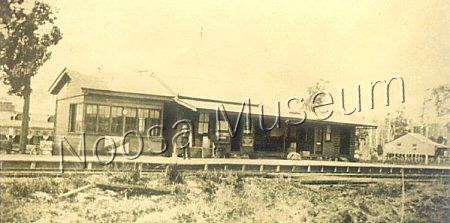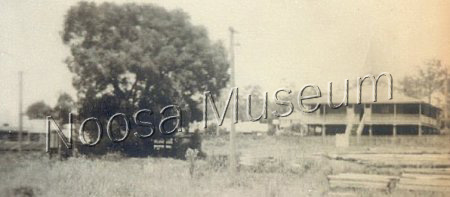Railway Display
Pomona's association with the railway can be traced back to the early days of settlement in the area. However it was the discovery of gold in Gympie by James Nash in 1867 and the resulting economic boom, which paved the way for completion of the line from Brisbane to Gympie by July 1891.
Settlements had already sprung up in the Ringtail, Tinbeerwah, Cooloothin, Skyring Creek and the Kin Kin areas as timber cutting and farming was proving successful. In the 1890s a group of settlers formed a deputation to the Railway Commissioner seeking a railway siding south of Cooran near Mt. Cooroora, which resulted in the establishment of a siding and a signal in 1895.
The residents chose Cooroora Siding as name for their new rail stop however both the Railway and the Post Office objected because of the similarity of the name to Cooroy and Cooran, so finally Pinbarren Siding was recorded by the Railway Department.
Sometime after 1900 the Pinbarren Progress Association was formed and in 1906 they were asked to submit a name for the subdivision. The name Pomona was submitted and accepted resulting in the registration of the town Pomona.
Pomona's association with the railway can be traced back to the early days of settlement in the area. However it was the discovery of gold in Gympie by James Nash in 1867 and the resulting economic boom, which paved the way for completion of the line from Brisbane to Gympie by July 1891.
Settlements had already sprung up in the Ringtail, Tinbeerwah, Cooloothin, Skyring Creek and the Kin Kin areas as timber cutting and farming was proving successful. In the 1890s a group of settlers formed a deputation to the Railway Commissioner seeking a railway siding south of Cooran near Mt. Cooroora, which resulted in the establishment of a siding and a signal in 1895.
The residents chose Cooroora Siding as name for their new rail stop however both the Railway and the Post Office objected because of the similarity of the name to Cooroy and Cooran, so finally Pinbarren Siding was recorded by the Railway Department.
Sometime after 1900 the Pinbarren Progress Association was formed and in 1906 they were asked to submit a name for the subdivision. The name Pomona was submitted and accepted resulting in the registration of the town Pomona.
By the end of 1960 changes were to take place that would alter the railway forever. By mid 1970 steam was at an end and diesel locomotive was king of the tracks. The Department first removed the water filling stations and coal facilities then the signalling system was overhauled resulting in automatic gates over the road crossing doing away with the gatekeeper who had been vigilant over the years.
By the end of 1970 rail freight had dwindled and the passenger rail service was in a decline all due to the family car and the semi-trailer. The Railway Department embarked on a major project to rationalise the department and reduce the operational costs, upgrading the rail system to electric rail and selling off railway buildings and property.
Pomona experienced the building sell off and the reduction of rail staff until the last remaining employee, the Station Master, finally finished his duty in mid 1991 and the building in which he had lived was considered redundant.
By this time Noosa Council was aware of the Railway Department strategy with building and land sales and moved to acquire some of the property within the shire. The Station Master's house and land was one of these as it was recognized that the property and building should be kept under the ownership of the community rather than pass to the private sector.
NOTE: Noosa Council acquired the property as a building of substantial worth on behalf of the community in August 1993 and it is now the location of the Pomona Community House.
By the end of 1970 rail freight had dwindled and the passenger rail service was in a decline all due to the family car and the semi-trailer. The Railway Department embarked on a major project to rationalise the department and reduce the operational costs, upgrading the rail system to electric rail and selling off railway buildings and property.
Pomona experienced the building sell off and the reduction of rail staff until the last remaining employee, the Station Master, finally finished his duty in mid 1991 and the building in which he had lived was considered redundant.
By this time Noosa Council was aware of the Railway Department strategy with building and land sales and moved to acquire some of the property within the shire. The Station Master's house and land was one of these as it was recognized that the property and building should be kept under the ownership of the community rather than pass to the private sector.
NOTE: Noosa Council acquired the property as a building of substantial worth on behalf of the community in August 1993 and it is now the location of the Pomona Community House.



